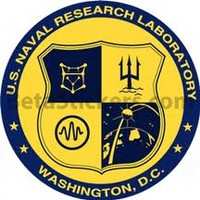Lab Collaborated With University Of Cincinnati, GE On
Research
 Advanced military jet aircraft have engines that provide the
needed speed and maneuverability. However, with this greater power
there is significant noise during takeoff and landing. The noise
can impact the public and affect the health and safety of flight
line workers. To confront the challenges of the noise problem, the
Naval Research Laboratory (NRL) collaborated with the University of
Cincinnati (UC) and GE Aircraft Engines to investigate the use of
mechanical chevrons (serrations at the rim of the exhaust nozzle)
and fluidics to successfully reduce the noise from supersonic
military jet aircraft.
Advanced military jet aircraft have engines that provide the
needed speed and maneuverability. However, with this greater power
there is significant noise during takeoff and landing. The noise
can impact the public and affect the health and safety of flight
line workers. To confront the challenges of the noise problem, the
Naval Research Laboratory (NRL) collaborated with the University of
Cincinnati (UC) and GE Aircraft Engines to investigate the use of
mechanical chevrons (serrations at the rim of the exhaust nozzle)
and fluidics to successfully reduce the noise from supersonic
military jet aircraft.
The initial research, sponsored by the Strategic Environmental
Research and Development Program (SERDP), revealed the potential
for significant noise reduction of high performance jet engines
without compromising performance or environmental standards. SERDP
is DoD’s environmental science and technology program,
planned and executed in partnership with DOE and EPA. The Navy
recognized this research as a Top Twenty Research Accomplishment of
2009.
NRL scientists, Drs. Junhui Liu, Ravi Ramamurti and Kazhikathra
Kailasanath from the Laboratory for Computational Physics and Fluid
Dynamics, performed computational analysis to characterize the flow
from the nozzle exhaust of a supersonic jet engine. Their findings
revealed that the spacing of the shock cells and the length of the
core increased as the ratio of the pressure inside the nozzle to
the pressure outside (total pressure ratio) increased. These
results were confirmed by experimental data from UC, showing that
computational analysis works in assessing the effectiveness of
chevrons and fluidics. The research team published their finding in
the American Institute of Aeronautics and Astronautics journal and
received a 2009 Alan Berman Research Publication Award for
outstanding archival research, as judged by NRL management.
 Following the successful simulations of the jet flow and noise,
the research team shifted their work to simulate and assess
specific noise reduction concepts. They conducted experiments and
simulations to assess the impact of the mechanical chevrons on the
flow from the exhaust nozzle and near-field noise. Their simulation
results revealed that the chevrons caused the shock cells to move
closer to the nozzle and reduce the spacing between them. The
chevrons also induced more spread of the jet flow and decreased the
strength of the shock cells. Together, these factors reduced the
noise significantly, by more than 3 decibels at the locations where
they tested.
Following the successful simulations of the jet flow and noise,
the research team shifted their work to simulate and assess
specific noise reduction concepts. They conducted experiments and
simulations to assess the impact of the mechanical chevrons on the
flow from the exhaust nozzle and near-field noise. Their simulation
results revealed that the chevrons caused the shock cells to move
closer to the nozzle and reduce the spacing between them. The
chevrons also induced more spread of the jet flow and decreased the
strength of the shock cells. Together, these factors reduced the
noise significantly, by more than 3 decibels at the locations where
they tested.
As a next step, the researchers replaced the mechanical chevrons
with fluidic injections of air at discrete locations along the jet
nozzle rim. Using a 1 to 2 percent injection of air under a variety
of operating conductions, the researchers achieved the same noise
reduction as they did using the mechanical chevrons. The advantage
of the fluidic injection technique is that it can be easily turned
on and off.
The researchers then investigated a combination of mechanical
chevrons and fluidics. They were able to improve the effect of the
chevrons on flow modification and noise reduction by properly
positioning the fluidic injections of air. They also injected air
upstream of the nozzle exit, near the throat, to effectively modify
the flow area. This modified the shock cell structures and reduced
the noise generated.
Working under the Office of Naval Research-Rapid Technology
Transition program, GE researchers then tested the mechanical
chevrons on a full-scale Navy engine. The tests, conducted at the
NAWC-Lakehurst Facility, proved the mechanical chevrons to be
effective, as predicted by the NRL simulations. Work will continue
on this project, using the validated computational capability, to
further increase the noise reduction level and advance the
technology. ONR is funding this research.
 Klyde Morris (10.27.25)
Klyde Morris (10.27.25) Airborne 10.27.25: MOSAIC Phase 1, Katana Returns, MOSAIC Town Hall!
Airborne 10.27.25: MOSAIC Phase 1, Katana Returns, MOSAIC Town Hall! Airborne-NextGen 10.28.25: Police Drones, Nat'l Parks v UAVs, MOSAIC Phase 1
Airborne-NextGen 10.28.25: Police Drones, Nat'l Parks v UAVs, MOSAIC Phase 1 ANN FAQ: Follow Us On Instagram!
ANN FAQ: Follow Us On Instagram! NTSB Final Report: Airbus A321-271N (A1); Cessna 172N (A2)
NTSB Final Report: Airbus A321-271N (A1); Cessna 172N (A2)




